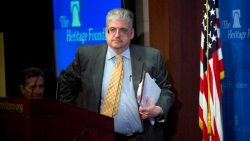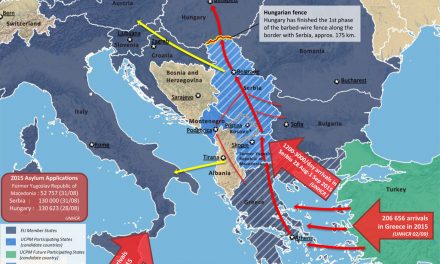A final battle against ISIS illuminates the failures of the war to destroy it.
BY SETH J. FRANTZMAN, Jerusalem Post
In Baghuz, a small village on the banks of the Euphrates River, ISIS has been pushed into a small area consisting of tents and fields. It’s truffle season in the Syrian desert and in between the battles the locals are able to gather truffles. But beyond the fields, the realities of the defeat of ISIS are becoming clear.
Up to a thousand fighters may be left in the little tiny pocket of ISIS control, writes Wladimir van Wilgenburg at Kurdistan 24. Some say it is just 700 meters across. Video captures the ISIS members walking around. They have no fear of a sniper picking them off. There is some kind of ceasefire. The ISIS members receive the mercy that they did not show others.
Amid the ceasefire come the trucks. An endless parade of trucks beneath the Syrian sky. The dozens of trucks have been used to take out some of the 5,000 people who have surrendered in Baghuz in the last several days. These are just the tip of the iceberg of tens of thousands who have suddenly appeared on the banks of the Euphrates in what was supposed to be the last battle against ISIS by the Syrian Democratic Forces and the US-led 79-member coalition. The whole tragic, sometimes farce, sometimes cruel outcome, symbolizes everything wrong with this war.
What has gone right? ISIS has been defeated. But everything else leaves more questions than answers. Let’s start with the huge number of ISIS supporters in Baghuz. How did all these people get there? Who are they? They have included thousands of Iraqis. These are mostly Iraqis from Anbar Province who supported ISIS and fled over the border in 2017 when the Iraqi army pushed ISIS out of Iraq. The Euphrates valley crosses the border a few kilometers away and for the tribes of the area there is no real difference between Iraq and Syria. During the years after the US toppled Saddam Hussein in 2003 this was conduit for extremists, insurgents, militants, jihadist, gun smugglers and everything else. Iraq complained for years to Syria that Damascus was funneling extremists down the river’s valley, called the MERV or Middle Euphrates River valley, into Iraq. The seeds of ISIS – the networks – began back then. It wasn’t a surprise that ISIS was able to take this area in 2013-2014. It isn’t a surprise that the last stand is happening here.
But is it a last stand. Tens of thousand of ISIS members are thought to have slipped into the desert, US commanders and others say. They have dispersed and decentralized. They have gone to ground. They have gone home.
What the local ISIS supporters left behind was the detritus of ISIS, the remnants of the foreign canton that were the spoiled and bourgeoisie ISIS members who came from abroad. ISIS attracted tens of thousands of foreign volunteers from all over the world. Last year, the Syrian Democratic Forces said they had 3,200 detainees from 41 countries. These included 800 men. And in Baghuz in the battles in January and February another 10,000-20,000 were added to this number. There are large numbers of western ISIS members, including all the infamous “ISIS brides” that have become celebrities over the last two weeks. But there are also, according to Wilgenburg’s report, Turks and Asians, as the SDF refer to ISIS fighters who came from Central Asia and places further east.
Mixed in among the foreigners are some of the victims of ISIS. The group was able to evacuate Raqqa in the fall of 2017 under a shadowy deal, and led thousands of its members to come here. Many western ISIS members who had relaxed in Raqqa from 2014 to 2017 came to Baghuz. ISIS brought some of its Yazidi slaves as well. These were people it kidnapped in 2014 during the attempted genocide of the Yazidi minority in Iraq. Yazidi children have been found and some have been reunited with their families.
Herein lies one of the failures of the coalition. While the countries are committing assets to fighting ISIS, they don’t commit many assets to help the victims. This leaves local volunteers to help traumatized children and victims, some of whom have suffered horrid sexual abuse and others who were brainwashed.
THERE IS ALSO not enough investment in infrastructure for the estimated 46,000 people who fled the Baghuz area in the last weeks. This is equivalent to a small city, and yet where are the hordes of NGOs that should be there to help and process these people. There appears to be little in the way of screening for many suspected ISIS war criminals. There isn’t enough being done to monitor those who are radicalized. Many of these people have lived under an ISIS regime for more than four years. That means they have been subjected to non-stop radicalization. Some describe beheadings and executions as normal as seeing the sun rise. Yet it appears that although some screening is done to weed out the worst male offenders, little is done beyond that. Despite the coalition having said that justice was a priority in its February 6 meeting in Washington, little has been done to investigate the potential crimes of those leaving Baghuz.
Some of these ISIS members have openly expressed support for ISIS as they left in trucks. If the US is seriously committed to stabilization then it should be monitoring this threat.
The defeat of ISIS leaves behind many problems. The landscape is littered with mass graves and ruins. Some 3,000 Yazidis are missing. Yet there seems to be very little investment in reconstruction and finding the victims. A mass grave with an estimated 3,500 people in it was found near Raqqa last month. It requires investment to identify those buried there.
Up the Khabur River from the Euphrates there are Christian village that were harmed by ISIS in 2015. They also need support to revive and feel security. Yet reports say that little has been done.
The home countries of many foreign fighters have indicated that they don’t want their citizens back. But they also oppose the SDF transferring those citizens to Iraq where they might face trial for crimes, or to the Syrian regime government. They also oppose the SDF releasing them. And they don’t want to pay to keep them detained in eastern Syria. This isn’t a solution. Some of the ISIS members came from the wealthiest countries in the world and are now being foisted upon some of the poorest people in the world yet the SDF is being asked to deal with them. Yet the coalition calls the SDF a “partner” and doesn’t see it as autonomous entity that can be treated like a state. So the detainees are left in this limbo, as are the victims of ISIS and the civilians and families of alleged ISIS members.
While there is talk of “stabilization,” it appears that the goal of the battle for Baghuz is simple to win, but not win the overall war by finding long-term solutions, or bringing justice. It’s a cosmetic victory and even in the victory the sense of victory is not clear. The members of ISIS who have surrendered seem cheerful and they seem to feel they got away with their crimes. Their wives chant support for ISIS. No one expresses remorse and they seem to know that they will be treated humanely and then released. It’s surreal to see them giving interviews like celebrities, relaxing in civilian clothes, having comforts that even seem to have been denied to some of the local fighters who defeated them.
THERE APPEARS to have been a rush to defeat ISIS in Baghuz without planning for the 46,000 people there. Little study was done on who these people are. Why were there so many foreign extremists gathered in one place? Who told them to go there? How did they get there? The SDF, cautious to suffer more casualties after the 10,000 it already suffered, is careful in this last campaign. The coalition is also careful, not wanting to carpet bomb a small area full of families and perhaps hostages as well. But the least one could do with so much time to plan this last battle is to create a well organized system to process the detainees, and figure out who they are and what threat they might pose. Instead it appears that many of the women and children have simply been allowed to move to Al-Hawl camp. Some of the men have been detained. But what’s the overall process, where will this all end?
With so many home countries of the fighters shrugging their shoulders and even the ISIS victims being quickly moved away to help them find their families – without much attention to letting them pick out the criminals who harmed them – much evidence is being lost of ISIS crimes. In the rush to get things done, some processes which might be put into place now to ensure the lasting defeat of the extremists, have not been put in place yet. There is little pause to consider lessons of past conflicts or to consider the lessons for the future. Given the ample warnings of a renewed ISIS insurgency, there are fears this victory could be hollow. This is especially true because questions hang over what comes next and how the US will manage to “withdraw” and also stay in Syria. The SDF has asked the US for answers and has not received any.
As the ISIS last remnants await what comes next, this final battle may symbolize much of what was wrong with the war in general: Lack of planning for the post-war period, too much focus on sensationalist stories of western ISIS members, lack of investment in victims, reconstruction or justice, and even the lack of caring for allies on the ground who sacrificed so much to bring peace to those areas.



















